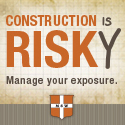| |
Contact Us Archives
Subscribe Printer-Friendly AdvertiseSafety and HealthConstructor Buyers' Guide Facebook 

Top News
Regulatory & Legislative Updates
Events
Member News
Safety Cabinet
|
|

We continue to hear from many contractors that finding workers is difficult, so we are once again conducting a survey of construction labor market conditions. While it is clear that worker shortages are a significant problem for many contractors, we feel it is important to continue our efforts to better quantify where these shortages are taking place, how severe they are, and what steps firms are taking to both cope with tight labor markets and improve the supply of new, qualified workers. Please take a few minutes to complete the following workforce survey.
The more people understand the scope, and consequences, of a tight construction labor market, the more likely they are to act on the measures we identify in our Workforce Development Plan that are designed to make it easier for school systems, local associations and private firms to establish career and technical education and training programs.
|
The AGC-Willis Towers Watson Construction Safety Excellence Awards (CSEA) recognizes those construction companies who excel at safety performance. The CSEA closely examines each candidate's commitment to safety and occupational health management and risk control. Unlike other safety award programs that limit the criteria to frequency rates, the CSEA selection process is considerably more comprehensive. Each application is reviewed for evidence of company management commitment, active employee participation, safety training, work site hazard identification and control, and safety program innovation. Over the past five years, the finalist judges have produced the CSEA Safety Management Showcase to share the best practices noted during the competition with the construction industry and any organization that places a high value on safety leadership. Please take the time to read through the Showcase, which has many takeaways for contractors looking to strengthen their safety program. Feel free to share the Showcase document with others..
|
Beginning on September 23, 2017, contractors must comply with OSHA’s respirable crystalline standard for construction, while Virginia Occupational Safety and Health began enforcing the new standard on June 23, 2017. To help educate AGC members, AGC has developed the " Respirable Crystalline Silica in Construction" members-only webpage designed to provide contractors with a better understanding of how to comply.
The information on the page includes the following:
- Plain text summary of the rule
- Compliance flow chart
- Enhanced Table 1
- Air monitoring and objective data collection form
The standard provides a comprehensive and complex regulatory scheme for protecting construction workers from exposure to respirable crystalline silica containing dust. The scope of the standard applies to all occupational exposures to respirable crystalline silica and significantly lowers the permissible exposure limit (PEL) from 250 micrograms/m3 to 50 micrograms/m3. In addition to the new PEL, contractors will also have to comply with a host of ancillary provisions such as respiratory protection (when required by the standard), housekeeping, medical surveillance, and recordkeeping.
AGC staff will continue to develop additional materials so check back periodically to see what’s new. If you have any questions, please contact Kevin Cannon at (703) 837-5410 or cannonk@agc.org.
|
The Occupational Safety and Health Administration will launch on Aug. 1, 2017, the Injury Tracking Application (ITA). The Web-based form allows employers to electronically submit required injury and illness data from their completed 2016 OSHA Form 300A. The application will be accessible from the ITA webpage.
Last month, OSHA published a notice of proposed rulemaking to extend the deadline for submitting 2016 Form 300A to Dec. 1, 2017, to allow affected entities sufficient time to familiarize themselves with the electronic reporting system, and to provide the new administration an opportunity to review the new electronic reporting requirements prior to their implementation.
The data submission process involves four steps: (1) Creating an establishment; (2) adding 300A summary data; (3) submitting data to OSHA; and (4) reviewing the confirmation email. The secure website offers three options for data submission. One option will enable users to manually enter data into a web form. Another option will give users the ability to upload a CSV file to process single or multiple establishments at the same time. A third option will allow users of automated recordkeeping systems to transmit data electronically via an application programming interface.
The ITA webpage also includes information on reporting requirements, a list of frequently asked questions and a link to request assistance with completing the form.
Under the Occupational Safety and Health Act of 1970, employers are responsible for providing safe and healthful workplaces for their employees. OSHA’s role is to ensure these conditions for America’s working men and women by setting and enforcing standards, and providing training, education and assistance. For more information, visit www.osha.gov.
|
|
|

 2300 Wilson Boulevard, Suite 300 · Arlington, VA 22201 · 703-548-3118 (phone) · 703-548-3119 (fax) · www.agc.org
2300 Wilson Boulevard, Suite 300 · Arlington, VA 22201 · 703-548-3118 (phone) · 703-548-3119 (fax) · www.agc.org
 Take AGC's Workforce Survey Today
Take AGC's Workforce Survey Today
